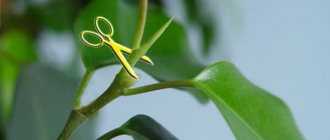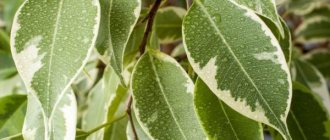If there is a beautiful ficus in the house, it will certainly take pride of place in the green corner. And this is not only because he has an attractive appearance. There are many beliefs and signs associated with the plant. It supposedly solves financial problems, helps childless couples become happy parents, heals and does much more. Believe it or not is everyone's business. But many people want to grow a beautiful flower at home. We have put together a selection of ficus varieties with photographs and names to make it easier to choose the best option for yourself.
Home care
Lighting
Bright light is needed. The best lighting will be provided by windows facing southeast, south or southwest.
“Summer vacations” in the open air of a balcony or area with mandatory protection from the scorching midday sun are useful.
Temperature
The best summer temperature range is from 20 to 25 degrees ; winter temperature should not be lower than 15 degrees.
ATTENTION : Drafts are contraindicated, as are frequent rearrangements.
REFERENCE : summer keeping in the open air can also cover part of the autumn, since this ancient, viable and hardy species is able to withstand even small short-term frosts
Priming
The optimal soil substrate should be slightly acidic or neutral, sufficiently loose and nutritious.
You can use ready-made soil for ficus plants, or mix two parts of turf and leaf soil with one part of coarse sand.
The following composition is also recommended:
- turf, leaf, peat soil with sand;
- all ingredients in equal quantities.
Planting and transplanting
The container for planting can be of a standard shape: (the vertical size is from a quarter to a third of the height of the plant), with a mandatory drainage hole.
Since stagnation of water is extremely unfavorable, leading to rotting of the roots, it is better to choose a porous material for the container - ceramics without a continuous layer of glaze.
A drainage layer of small pebbles or expanded clay must be placed at the bottom of the container.
During planting, as you fill up the soil, when filling the voids between the roots, you must be careful not to bury the root collar of the plant: it should be level with the ground. If the plant is tall, you need to take care of support for its trunk.
After planting, the ficus should be watered.
Young plants are replanted annually in spring or early summer, and mature specimens - once every few years , and the signal for replanting is the complete entanglement of the earthen coma with roots. Then the plant is transferred to a new pot, preserving the earthen lump.
ATTENTION : To limit the growth of this potentially large tree, it should not be transplanted into overly spacious pots: for young ficuses, the diameter of the new pot should be only 2 cm larger than the previous one, and for mature ones - 6 cm.
Large adult plants are not replanted, limiting themselves to replacing the top layer of soil in the container.
After purchase, in any case, the plant is not replanted immediately, giving time (from two weeks) to acclimatize to the new conditions for it.
Tip: If your “new baby” arrived in a cramped pot for transportation and in a special transport soil, it should be replanted in a container of a suitable size with a nutritious soil mixture.
Watering
In the summer, water, as a rule, once or twice a week with well-settled, soft, not cold water, avoiding stagnation of moisture.
Excess irrigation water accumulating in the pan is immediately drained.
The frequency of winter watering is from weekly to twice a month: the cooler the winter, the less frequent the watering.
Air humidity
It is necessary to maintain high air humidity, similar to the conditions in which this ficus grows in nature.
In summer, daily spraying with soft water at room temperature is mandatory.
The leaves are wiped weekly with a damp soft sponge.
In winter, if the air is not very dry, spraying can be replaced by wet wiping.
Top dressing
From spring to autumn, twice a month, fertilizing is carried out alternately with mineral and organic complexes, while ensuring a high nitrogen content.
Important : Fertilizer solutions should not come into contact with leaves and buds.
If the winter is warm, fertilizing is not stopped.
If kept cool and light, feed less frequently in winter.
Growth and pruning
The large-leaved ficus grows very quickly and, if its growth is not limited by pruning, it may very soon try to break through the ceiling.
Mandatory annual pruning, in addition to limiting the height of the plant, stimulates branching and the formation of a more luxuriant crown.
This operation is carried out in early spring.
When pruning thin shoots, straight cuts above the bud are used, and for thicker shoots, oblique cuts are used.
On ficus plants located in a sufficiently humid environment, aerial roots form.
They are not removed, but, as they grow, are directed to the soil surface.
Thanks to its rapid growth and active branching after pruning, this giant is an excellent material for creating spectacular bonsai trees - but only large ones, no less than a meter.
In this case, replaceable wire frames, targeted trimming, and tension support systems are used.
With age, the bark of the large-leaved ficus becomes very dark.
Other types of ficus are also suitable for growing magnificent bonsai trees, such as Ginseng, Microcarpa, Eden, Benedicta, Carica, Bengal, Lirata, Balsamina, Retusa and Blunt, the features of caring for which we talked about in separate articles on our portal.
Peculiarities
Ficus with large leaves is an ancient species of evergreen plant of the mulberry family, which is grown not only in artificial conditions, but also in Australian, New Zealand, Portuguese, Californian forests and park areas.
Biologists identify the following most popular names for broadleaf ficus:
- Tineke;
- Bengal;
- Belize;
- Robusta;
- Melanie;
- Large-leaved.
In a young plant, the color of the trunk is rich green, while in an old plant it is dark brown. Ficus with large leaves not only decorates the room, but also absorbs formaldehyde, ammonia, benzene and other substances hazardous to health.
How to propagate ficus macrophylla?
Ficus is propagated vegetatively - by cuttings and air layering.
Propagation by cuttings
Spring and summer cuttings are used: apical cuttings 10-15 cm , as well as stem cuttings with several leaves.
Wash off the milky juice that appears on the cuts.
The lower leaves are removed, and the rest are wrapped in a not too tight tube and secured in this state to reduce evaporation through the surface of the leaf plate.
You can pre-root the cuttings in water or immediately plant them in a light soil mixture.
The prepared cuttings are planted in a soil substrate made of equal amounts of perlite, or coarse sand and peat, covered with plastic film.
Keep at a temperature of 22-24 degrees , ventilate and moisturize.
After the roots have formed and new shoots have appeared (after about a month), the cuttings are planted in separate containers with the usual soil mixture for ficuses.
Reproduction by air layering
Before the beginning of the growing season, at the end of winter, an incision is made on a semi-lignified or completely lignified shoot, the area is wrapped in moist sphagnum, covered with plastic film and secured.
The moss must be constantly moist.
As a rule, after a month roots appear, growing through the sphagnum.
Then, having separated the tip of the shoot along with the sphagnum and the resulting root system, it is planted in a pot with a standard soil mixture.
Signs of trouble
Leaves fall - the result of insufficient lighting, drafts, frequent rearrangements, as well as temperature fluctuations and waterlogging.
Optimal care must be provided. The same can be observed in a recently purchased specimen that is experiencing stress due to a sudden change in living conditions.
The tips of the leaves have turned brown and dried out - the air in the room is too dry.
Spraying required.
The leaves turn yellow - this is a consequence of a number of reasons:
- Excessive application of fertilizers. Eliminated by abundant watering, after which fertilizing is not applied for two months;
- precipitation of large amounts of salts due to watering with hard water. In this case, replanting with soil replacement is necessary;
- the volume of the pot is too large. Needs replanting into a smaller container;
- Root rotting.
Damaged areas of the root system should be removed and the plant should be replanted in fresh soil.
If the process has gone far, you can try cutting and rooting the cuttings and eliminating the rest of the plant.
Slow growth - can be caused by a lack of light, feeding or too tight a container.
It is necessary to optimize the conditions of detention, allocate a more spacious container.
Leaf method
Large-leaved ficus trees can also be propagated using the leaf method. True, it is closer in technique to cuttings and does not involve propagating a plant from individual large leaves. To resort to propagation using this method, take a shoot with a leaf, since it is in the axil of the leaf that the bud will develop, from which a young shoot will grow. If you pick a large leaf directly, it may even give roots, but a new plant will not develop from it and there is no point in rooting it.
Unlike the previous method, the cut is made precisely along the internode. After cutting the cutting, place it in water to root. As in the previous case, you can plant directly into the ground, deepening to the leaf petiole. It is advisable to roll the sheet itself into a tube and secure it. Some people recommend using a thin rubber band or electrical tape for this purpose, but the gentlest choice is a soft wool thread. The care conditions are the same as for cuttings.
Photo
In the photo there is a large-leaved ficus:
Ficus plants amaze with the variety of their species, and some of them are truly spectacular and charming. Want to make sure of this? Read our articles about the bright De Gantelle, the mysterious Varietis, the popular Moklama, the capricious Dwarf, the graceful Pumila White Sunny, the tropical Ampel, the royal Amstel King, the comfort-giving Triangular and the hardy Ali.
Diseases and pests
Care errors, primarily stagnation of water and excessively humid air, combined with low temperatures, lead to weakening of the plant and its damage by fungal infections.
In this case, you need to optimize watering, spraying, temperature and treat the ficus with fungicides.
Ficus can be attacked by mealybugs, spider mites and scale insects.
Prevention against such “guests” is regular washing of the leaves, but if insects appear, the first measure is to remove the pests using a cotton swab dipped in alcohol or treatment with a soap solution.
Advice : The most effective remedy for pests is systemic insecticides.
The process of propagation by air layering
Now you know for sure whether ficus can be propagated by cuttings. However, not in all cases the two methods described above are used. Sometimes it is easier to propagate an old tree-like ficus using air layering. This procedure is considered quite complex, so it is recommended that only professionals use it. You can learn how to propagate ficus with branches from the algorithm of actions, which is described below.
- We determine the optimal height at which the layering will be located. It is necessary to choose a place so that the flower does not bend too much. Otherwise, the branch may simply break.
- We cut off an adult leaf at the cutting site and make a small vertical cut at the cut site. We place a match inside so that the hole always remains open.
- Take a small amount of damp moss and place it on the air layer. You can secure sphagnum moss using regular cling film. However, be sure to leave some air underneath.
Once all stages are completed, it is necessary to continue caring for the adult plant in the same way as was done previously. After 3-4 weeks, the moss will be overgrown with young roots, after which the film can be removed. All that remains is to separate the cuttings from the main part of the plant and place the branch in a new container. Further care for a young flower is no different from the rules for caring for cuttings.











